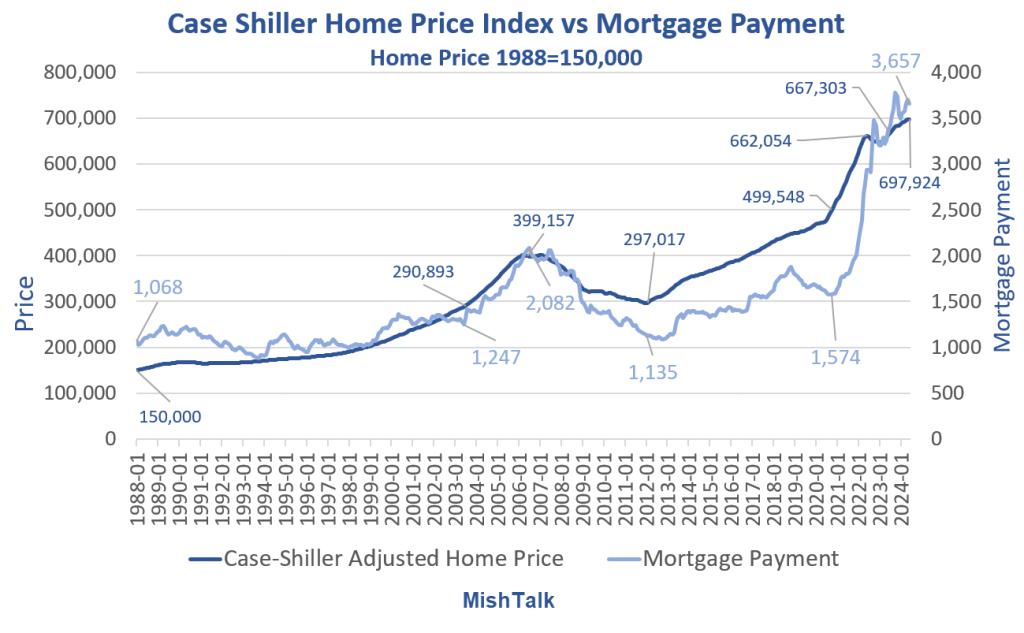The American dream, of buying a home and raising a family is all but dead for many Americans, especially generation Z.

Case-Shiller Home Prices vs Average Hourly Earnings Since 2000
- Home Prices: +49.1 Percent
- Average Hourly Earnings: +25.9 Percent
- Rent: +23.5 Percent
- CPI: +20.9 Percent
Case-Shiller Home Price Index vs Mortgage Payment

The above chart shows how the mortgage payment varied over time along with the purchase price of a home and the prevailing interest rate.
For example, a home that cost $150,000 in 1988 had a mortgage payment of $1068 per month.
That exact same house cost $499,548 in October of 2020 but the mortgage payment only rose to $1,574.
This is because mortgage rates fell to 2.68 percent from 10.38 percent.
Mortgage Payment and Mortgage Rate

For the same house, mortgage payments rose from $1,583 per month in October 2020 to $3,657 in June of 2024.
Mortgage payments are up 131 percent in that time frame.
That is just the mortgage payment. Factor in insurance, utilities, and property taxes.
The Unreachable American Dream
The Wall Street Journal has an article today on how The American Dream Feels Out of Reach for Most.
A July Wall Street Journal/NORC poll of 1,502 U.S. adults shows a stark gap between people’s wishes and their expectations. The trend was consistent across gender and party lines, but held more true for younger generations, who have been priced out of homeownership and saddled with high interest rates and student debt.
While 89% of respondents said owning a home is either essential or important to their vision of the future, only 10% said homeownership is easy or somewhat easy to achieve. Financial security and a comfortable retirement were similarly labeled as essential or important by 96% and 95% of people, respectively, but rated as easy or somewhat easy to pull off by only 9% and 8%.
Twelve years ago, when researchers at Public Religion Research Institute asked 2,501 people if the American dream “still holds true,” more than half said it did. When The Wall Street Journal asked the same question in July, that dropped to about a third of respondents.
“Key aspects of the American dream seem out of reach in a way that they were not in past generations,” says Emerson Sprick, an economist at Washington, D.C., think tank the Bipartisan Policy Center.
Pictures vs Anecdotes
The WSJ discussed anecdotes of those struggling. But pictures, not anecdotes show the true nature of the problem.
About 90% of children born in 1940 were ultimately better off than their parents according to research by Massachusetts Institute of Technology economics professor Nathaniel Hendren and Harvard University economist Raj Chetty.
Only around half of those born in the 1980s were able to say the same.
The article did not mention those born in the 1990s, but the above charts tell the story. Most in Generation Z are not as financially secure as their baby boomer grandparents at the same age.
Fed Myopia
Every member of the Fed as well as the typical economist will look at the first chart and not see inflation because they have been trained not to see it.
In the blind eyes of these economists, home prices are not inflation or a result of inflation because they consider homes to be a capital expense, not a consumer expense.
OK, so what? It should be clear by now that inflation matters, not just consumer inflation.
But this group of brainwashed economists somehow believe that only consumer inflation matters.
Moreover, the Fed spent 10 years trying to force inflation higher, in an incredibly foolish attempt to make up for lack of past inflation.
What a hoot.
Case-Shiller Home Price Index Hits Another New Record High
Yesterday, I noted Case-Shiller Home Price Index Hits Another New Record High
People who want a home but cannot afford one keep watching home prices soar out of sight. The Fed says this isn’t inflation.
Not Inflation?!
Home prices were the subject of a discussion of several friends and me over the course of the past few days ahead of the article.
I put together this synopsis.
- The Fed via QE lowered rates to zero hoping to achieve inflation. Success!
- Mortgages fell to under 3 percent for a year.
- Everyone who had a mortgage refinanced putting money in their pockets.
- With rates at 3% and free money pandemic aid, demand for houses soared.
- The Fed failed to see rising home prices as inflation.
- And the Fed thought three massive rounds of free money, eviction moratoriums, and student debt cancellation would not cause inflation. “Inflation is transitory,” said every member of the Fed.
- People are now trapped in their homes unwilling to trade a 3% mortgage for a 6.5% mortgage.
- The Fed gets grade F from every angle.
So now we have a different kind of housing bubble and crisis. And it’s all because economists do not view home prices as inflation.
The Fed never learns from mistakes. Instead, it doubles down on them. This is absurd no matter what angle you look at.
Recession Has Arrived
August 20: Improving the McKelvey Recession Indicator, No False Negative or Positive Signals
Adding the job vacancy rate to the McKelvey (Claudia Sahm) recession signal eliminates false negatives and false positives, and provides a much faster signal than Sahm.
August 20: The Share of People Seeking a Job Is the Highest Level Since 2014
A New York Fed survey shows a huge increase in the percent of job seekers. It’s especially pronounced for those making less than $60,000.
August 8: Trump Fires Arrows Missing the Target Badly, Will a Recession Save Him?
I don’t know the answer to that question, and nobody else does either.
Since February, I have been posting that young adults, renters, and Blacks will decide the election.
Those are the groups most left behind in the current housing mess.
